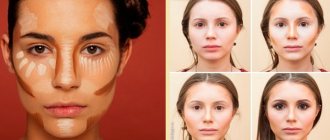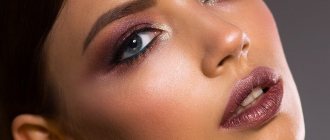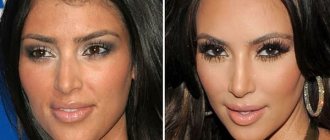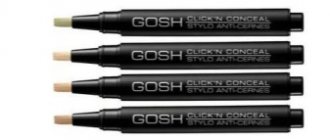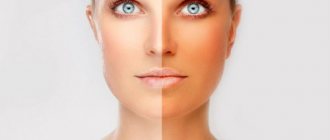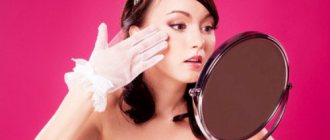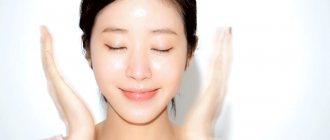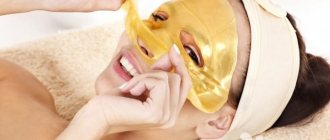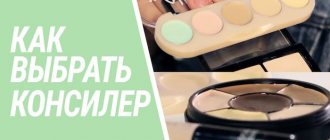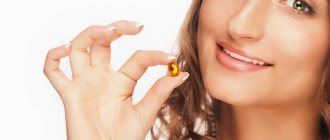The modern beauty industry offers girls many ways to achieve and maintain an ideal appearance. Decorative cosmetics allow you not only to emphasize your advantages (for example, highlight your lips with color or visually enlarge your eyelashes), but also to hide your flaws. By the way, the desire to cover up pimples or scars is often a factor due to which the fair half of humanity discovers the world of makeup. However, with practice many problems arise. Why do red spots still show through? How to prevent powder from rolling off? For what purpose are pink and green corrective agents used? This is just a small part of the questions that newbies have. In this material you will learn how to properly use face corrector step by step with a video and analysis of the colors of the palette.
What kind of remedy is this
You can guess the main purpose of corrective pigments based on their name. Its main goals are:
- masking acne, pimples and redness;
- tone alignment;
- visual elimination of irregularities;
- contouring features;
- hiding bags and circles under the eyes;
- eliminating traces of fatigue and lack of sleep.
It is worth noting that camouflage cosmetics only help to create the effect of getting rid of problems. It will not get rid of pimples, but will only hide them. Skin problems need to be treated by specialists, and corrective products make you feel more confident and beautiful. By the way, sometimes you can get a “medicinal” effect from them: some types dry out slightly, but this, of course, does not replace medical creams.
How to paint your face with correctors: we understand the varieties
Cosmetics manufacturers market concealing products in a variety of forms. Among them, both a professional makeup artist and a simple amateur will be able to find the most suitable version. They all differ in structure, configuration and mechanics of use.
In the form of lip gloss
Inside such a jar most often there is a liquid cosmetic product, which is applied using a special brush. This type is very convenient for camouflaging large areas of skin. You can apply it to the area under the eyes, cover up redness on the forehead or chin. Sometimes it has too dense a texture, and therefore often gets clogged into pores and rolls off. To avoid this problem, it is worth applying the product in a thinner layer. In this form, highlighters and concealer cosmetics are produced in different colors.
Stick
In texture, it resembles something between lipstick and butter (hard cream) for business. Most often, the stick is used to spot mask imperfections. Did a pimple pop up suddenly? No problem! A corrective will help solve this problem. In addition, such a corrector is very convenient to carry with you. It is compact and quite dense, which means it won’t spill all over the bag. Sometimes antiseptic substances are added to its composition. They dry out the pimple a little and promote its speedy healing.
Pencil
The correction rod does an excellent job of masking very minor imperfections. With its help, you can remove or draw on (if the image requires it) freckles and moles, hide blackheads and small pimples. The pencil is also often used to draw the contour of the lips: this allows you to make them larger. With a white tint you can visually enlarge your eyes. To do this, you need to draw the growth line of the lower eyelashes. Face correction using pencil-shaped correctors gives a very lasting result.
Palette
This is the most common type of corrective substance. Makeup artists and hobbyists buy it for its convenience, versatility and benefits. The texture of cosmetics in such sets can be creamy or dry. Under one lid in different cells there can be from two to twelve (and sometimes more) different masking agents. The kit usually includes highlighter, contouring and enhancement products. Among the color palette you can see shades of brown, flesh, green and pink.
Separate jar
Applying concealer to your face can be a real art! In this case, the creators are professional makeup artists. They often choose powder concealer products to work with. They contain no unnecessary binders, which gives purity of color and texture. They are applied with a brush. The dry structure allows you to independently control the saturation and density of makeup application. You need to be extremely careful: there is a high chance of overdoing it.
Summarize
A face corrector is necessary for almost every woman, since it is extremely difficult to find a person with perfect skin. The corrector helps to disguise imperfections on the face accurately and precisely. There is no need to cover your entire face with a thick layer of foundation when the pimple is only on your forehead or chin. It is enough to apply the corrector of the desired color to the problem area, and then cover it with foundation.
The use of correctors in everyday makeup has long become the norm, and for the evening version it is completely necessary. Do you use makeup correctors?
Share with your friends!
Read us in the Zen channel
Shades
Many girls who are just beginning to learn the basics of camouflage make-up are primarily interested in how to properly apply the palette and use color correctors for the face. The bewilderment is quite justified: in a palette you can often find almost the entire “rainbow” of colors! In fact, each of them is designed to correct different areas. All of them are used in different situations and somehow magically cope with their mission.
Green
It perfectly eliminates red color. It should be used if you have the following skin problems:
- acne;
- strongly protruding vessels;
- burns;
- redness.
Pink
This color works well in dark places:
- circles and bruises under the eyes;
- dark spots;
- hematomas;
- inflammation near the wings of the nose.
Purple or lilac
The shade is able to neutralize yellowness. It should be used to eliminate the following shortcomings:
- yellow spots;
- bruises;
- too dull skin;
- sunburn.
It is worth noting that this color is not suitable for dark-skinned girls.
Yellow
This is a real must-have for eliminating excess blue stains! You can use it to disguise:
- signs of lack of sleep;
- translucent wreaths;
- pimples and small hematomas.
To ensure that it “lays” well and does not get caught in small folds and pores, it is better to mix it with powder.
Shimmering White
The scheme for applying correctors to the face often involves placing accents. This is most conveniently done using a highlighter. It allows:
- visually enlarge the eyes;
- give the skin a fresh, healthy glow;
- visually correct the shape of the skull.
The main thing in this matter is to stop in time. It's easy to go overboard when working with shiny particles.
Brown
This color comes in several shades in palettes. All of them are great for contouring. With their help you can:
- draw cheekbones;
- darken the upper part of the forehead;
- correct the shape of the nose.
When sculpting, it is important to shade the cosmetic well. This will help create a natural shadow effect.
Light beige
It looks more like a concealer. It's great for covering up dark circles, blemishes and redness.
What types of proofreaders are there?
Correctors come in a variety of colours, appearances and textures. With this in mind, they are used for various purposes.
This product is divided into the following varieties:
- Dry.
- Cream.
- Pencil.
- Oil.
- Stick.
- Liquid.
- Auto.
- Palette.
- Compact.
Read more about each type below.
Liquid
The liquid corrector has a consistency similar to a fluid foundation. Since this concealer is water-based and non-greasy, it is not so easy to use. Therefore, it is necessary to distribute the product very quickly, otherwise there is a risk of hiding some shortcomings while emphasizing others. In order to use this product yourself, you need to stock up on a comfortable brush.
The best option is to trust the hand of a professional.
It is a little easier to use an automatic pencil, since the corrector is distributed evenly on the brush. This type of concealer masks problem areas around the eyes very well.
Stick
The product is very convenient to use. It has a good consistency, thanks to which it is easy to apply, does not get caught in folds and wrinkles, and is not able to spread over the skin. Therefore, this product can be easily used even by those who have never used a face concealer before.
Thanks to modern formulas, solid correctors are created with a very delicate texture and a variety of vitamin supplements. This has a very good effect on the condition of the skin of the face. This type of corrector eliminates minor local redness, scars and pimples.
Pencil
The pencil often contains various antibacterial components. This has a very beneficial effect on problematic or oily facial skin. The pencil has very good staying power. Besides correcting imperfections, it can also be used in place of a highlighter or primer.
Thanks to the pencil, you can increase or decrease the volume of your lips, add richness to bright lipstick or shadows. You can also visually raise the area under the eyebrow, making a woman’s look more “open”.
Cream
Quite a popular type of corrector. Sold either in jars or in palettes of 4-6 colors. They must be mixed together to create the perfect tone. Allows you to solve problems of several types of problematic skin. It has a fairly dense texture, which makes it possible to perfectly mask various imperfections: acne marks, scars, age spots and dark spots.
Dry
It is not very common, but it is a lifesaver for girls who have very oily facial skin, as it creates a mattifying effect.
Thanks to the different shades, you can perfectly hide skin redness (using a corrector with green pigments) or any age spots (using a corrector with purple pigments).
Auto
The advantage of this type of corrector is the uniform distribution of the decorative product on the brush. This is very convenient when applied to the skin of the face.
Compact
It masks problem areas of the skin well and also reduces them in the shortest possible time. Very convenient to use and transport.
Oil
The consistency of the oil corrector is reminiscent of theatrical makeup. Ideal for camouflaging dark circles in the eye area, various age spots or other severe skin imperfections. Thanks to its dense texture, this type of corrector allows you to create a perfectly even face texture, as it completely hides all imperfections.
It is very convenient to use this type of corrector, since the product is not very liquid.
Mineral
Mineral corrector effectively hides skin imperfections and disguises dark circles in the eye area. This helps maintain a natural appearance. This corrector does not create a mask effect, does not weigh down the skin, and feels comfortable on it. It contains a complex of plant extracts and useful mineral components. This has a very good effect on the skin of the face.
Palette
A unique invention that will help cope with various facial skin defects in a matter of minutes. The corrector palette can include up to 25 different colors, which are designed to correct many dermal problems. It is very important to use shades correctly in order not only to highlight the advantages of the skin, but also to hide unwanted imperfections.
Don't miss the most popular article in the section: Face fitness for facelift, rejuvenation, muscle tone. Master class from Elena Karkukli
Textures
One of the most important steps to understanding how to apply facial concealers is the composition of the cosmetics. Having a good understanding of this topic, you will be able to choose the right product for your skin type, and then your makeup will lie smoothly and harmoniously.
Liquid
The form of this product is similar to a light fluid or foundation. It is ideal for dry and normal epidermis types. It can often provide additional hydration. Due to its texture, it blends out perfectly. It is best to use a sponge or a thick brush with it.
Creamy
In operation, it can be compared to a body butter or cream shadows. It adheres very well to the skin, but is quite difficult to blend. Girls with increased secretion of subcutaneous fat are better off avoiding cosmetics with this structure: it can impart an inappropriate oily sheen.
Dry
To produce this product, pure pigment is pressed with mineral binders. The result is something like powder. It is best used by girls with dry and normal type of epidermis. The crumbly product lays down in a light layer and looks quite natural.
Concealer and corrector: what's the difference?
Many girls do not see the difference in these two products and are sure that they perform the same functions.
But concealer and corrector differ in several ways:
| Corrector | Concealer | |
| Structure | Dense, thick | Delicate and light, liquid |
| Operating principle | Lightening of pigmentation, single camouflage of circles under the eyes, for spot masking of minor skin imperfections (pimples and scars) | Face sculpting, toning dark circles under the eyes, evening out tone, lightening fine wrinkles |
| Palette of shades | Green, yellow, purple, orange | Pink, beige |
| Antibacterial components with a drying effect | Included in | Not included |
| Application area | Spot on the face, only in those places where there are defects | Can hide large areas of skin |
| Application | Before foundation | Over foundation |
How to properly apply concealer to your face: step-by-step tips with photos and videos
To achieve the effect of visual plasticity, just follow the following basic steps.
- It is important to ensure good care before applying makeup. Wash your face with cleansing foam or milk, then use a toner and apply a moisturizer suitable for your skin type.
- Apply a primer or base - this will guarantee durability.
- Create an even tone using powder, BB cream or foundation.
- Using a color that is two shades darker than your natural color, draw two straight lines along the edges of the bridge of the nose.
- Highlight your cheekbones. To “find” them, you can pull your cheeks in like a fish and draw stripes along the sunken areas.
- A photo of how to properly apply concealer to your face often involves darkening the top of your forehead. Apply a few strokes of dark cosmetics along the hairline.
- Highlight the apples of your cheeks, add a little highlighter to the inner corners of your eyes, as well as to the bow of your upper lip, under your eyebrow and on your chin.
- Blend your corrective makeup. Start with light areas and then gradually move to dark areas. Stop periodically to check your makeup in good lighting conditions. Make sure that the sculpting looks as natural as possible.
- Complete your makeup with other details: apply eyelashes, lipstick and eyebrows.
How to cover up age spots
Actions:
- A primer is applied pointwise to pigment spots or the entire face.
- At the first stage, you need to use a tint corrector (select the desired color). The product is applied to the stain, going slightly beyond its boundaries. Wait until it is slightly absorbed and carefully blend the contours.
- The foundation begins to be applied exclusively from the area that is subject to correction, using neat movements. It needs to be distributed over the entire skin of the face.
- If the pigment spot is very noticeable, at the initial stage you can apply a white pencil or a light concealer under the corrector.
- Light spots are hidden with a concealer that is 1-2 shades darker than the foundation.
- Conclusion – applying powder. Movements in the area of the stain should be as careful as possible. You can also apply the powder through a napkin (to be on the safe side).
How to hide wrinkles
Age leaves its mark on the face, but this is not a reason to stop taking care of yourself. With the help of simple techniques you can turn all disadvantages into advantages.
- Choose a very light foundation. You can also use an emulsion or filler.
- A yellow or beige tint will help hide facial wrinkles. Apply a little makeup and then set it with powder.
- You can get rid of wrinkles in the nasolabial folds using a light pink pencil. They can also be used to accentuate the arch of the eyebrow and the inner corner of the eye.
- It is better to apply cream or gel shadows with shimmer on your eyelids. Instead, you can use any light product from the corrective set.
How to disguise bruises and dark circles under the eyes
Actions:
- When bruises are very noticeable under the eyes, it is necessary to use a corrector in a pink, yellow or orange shade. A corrector 1 shade lighter than the skin is applied on top, or this area is immediately treated with a suitable foundation.
- In order to camouflage dark circles, you need to use a corrector of the required color. A pinkish tint is suitable for fair skin, peach for medium skin tones, and orange for dark skin tones.
- You need to apply a corrector of a certain color in the same way as a concealer or a standard nude.
Errors during use
It is very difficult to achieve an ideal result the first (and sometimes even the second and third) time. Even experienced makeup artists sometimes encounter small mistakes. The most common of them are collected in the list below.
- Wrong selection of cosmetics. A discrepancy between the skin type and the texture of the product can greatly affect the quality of the make-up and aggravate all imperfections.
- Wrong choice of shades.
- Insufficient shading. If you don't blend the cosmetic product to the right extent, it will look unnatural and awkward. At the end of the makeup process, make sure that all the brown streaks create a shadow effect, and the green, lilac and pink strokes are well hidden by the tone.
Correction of facial oval
Cosmetic facial correction is a visual change in proportions (increase or decrease in individual features) by creating the correct balance of light and shadow. This concept is very close to the popular techniques of contouring and strobing, whose effect extends not only to the general improvement of the oval, but also to the sculpting of the nose, lips and eyes.
There is no general universal recipe for modeling an ideal oval, although makeup artists have developed a scheme for each face shape, following which you can easily achieve the desired result.
Corrective agents
NYX Professional Makeup collections have everything you need. It is believed that to create a light corrective effect, a minimum set of just 2 products is sufficient, including one cosmetic product 1-2 shades lighter and one slightly darker than the natural complexion. An even more compact option, such as the Wonder Stick, combines both highlighter and concealer in one stick.
Tools for more thorough modeling are:
- • Foundation that evens out skin color and prepares the base for subsequent correction - you can give preference to both mattifying options, like Stay Matte But Not Flat Liquid Foundation, and “illuminating” makeup bases, for example, Hd High Definition Foundation.
- • Corrector and (or) concealer that hides skin imperfections (inflammation, redness or pigmentation) - for 100% elimination of problems, both individual product options and color correction palettes, for example Color Correcting Palette, are provided.
- • Highlighter, necessary for highlighting certain areas of the face - you can achieve a natural glow with universal products for the face and body, like Born To Glow Liquid Illuminator, and with a special illuminator, such as a pencil in the form of a Strobe Of Genius Holographic Stick.
- • Bronzer or sculptor that creates a shadow effect - to add expressiveness to facial features, it can be complemented with reflective elements, as in the Illuminator shimmering bronzing powder.
- • Blush that gives the face a fresh color and flush - a classic compact version of blush, such as High Definition Blush, or a two-color gradient product, such as Ombre Blush, can create the desired effect.
- • Setting powder for correction will help smooth out the transitions between products and complete the look - loose products, similar to the finishing powder SFX Setting Powder, do this best.
Often, all the necessary products can be combined in a ready-made correction palette. Such products include the universal Highlight & Contour Pro.
Dry or oily correction: which is better?
Depending on the texture, all corrective cosmetics are usually divided into dry, liquid and cream. Such a difference affects not only the process of applying the product, but also the final result of the makeup.
Dry correction is good when you need to create a light modeling effect. In this case, cosmetics will not be able to significantly change the proportions of the oval of the face, but will look natural even in bright daylight, which is why this technique is indispensable for everyday make-up. Textures like these are great for those with oily skin: many pressed and loose products are lightly absorbent and reduce the risk of makeup “smearing” throughout the day.
Thicker concealers adhere well to the skin and are great for creating the perfect evening makeup. Creamy texture is a great option for dry skin.
Regardless of the type of product chosen, it should be remembered that its contour shading must be very careful and soft, otherwise, instead of an ideal correction, you will get the effect of a mask or stage makeup. The boundaries of any texture are smoothed out with professional tools: sponges, correction brushes, such as Flat Contour Prob23 and Holographic Halo Sculpting Highlighting Brush.
Buying tips
A step-by-step photo of how to properly apply concealer to your face will help you understand the secrets of the skill only if you have high-quality cosmetics.
Below is information to help you choose one.
- Look at the expiration date. Expired goods lose their properties and often cause allergies and redness.
- Use testers. Apply a little pigment to your wrist to check color and texture compatibility.
- Buy from trusted places. Nowadays, it is not difficult to stumble upon a fake from an unscrupulous manufacturer. Only a good supplier will help you avoid this trouble.
Makeup is not easy, but very interesting! Many skills come with practice, and therefore we advise you to quickly arm yourself with the necessary tools and head to the mirror. Now you know how to properly use face concealer step by step. Good luck!
Release forms
How you apply concealer to your face is determined by its texture.
The texture of the product will differ depending on the form of release:
- Concealer with brush. This is a bottle that ends with a brush. As a result of pressing on it, the product saturates the brush and is applied to the desired areas. You need to distribute it with line movements and then shade it.
- In a tube. The texture of the product can vary from liquid to creamy. This concealer can even out skin tone, brighten and make minor imperfections invisible. The liquid texture blends well, but does not cover significant unevenness well. The creamy texture is more versatile, but it won’t hide severe redness either.
- With applicator. The applicator is a brush or brush like a lip gloss. The consistency of the products is also similar. It can be used dotted or shaded in small areas.
- In a stick. The shape resembles lipstick. The texture of this product is thick. This concealer covers and mattifies well. Often the composition contains moisturizing and caring components: beneficial extracts, oils. But it cannot be used to treat the under-eye area.
- Solid. Designed for spot application to mask imperfections. It doesn't require much blending.
- Case. A thick concealer is placed in this form. It is applied with a brush.
- Palette. The palette includes several concealers in different shades, each of which performs specific tasks.
- Powder. This product with brightening properties can mattify, even out tone, and give freshness to the skin. But due to its texture, loose concealer emphasizes flaking and wrinkles. But it is indispensable for oily skin, as it absorbs oily shine.
The concealer may contain reflective particles, which allows it to be used as a highlighter. In this case, it is especially preferred for use under the eyes. Concealer containing zinc has an anti-inflammatory effect, while vitamins and antioxidants nourish the skin.
Antibacterial components prevent the development of infection, soothe inflammation, salicylic acid reduces skin oiliness.
Rules and recommendations for application
Experienced makeup artists advise how to apply concealer to your face correctly:
- Before applying concealer, you need to moisturize your skin and let the cream absorb.
- Defects are corrected with concealer after applying the main tone; concealer is not used as a foundation.
- You need to blend the concealer with warm fingers. It is enough to rub your palms together. The warmth of your hands will make the product more liquid and blend better. However, it makes no sense to make a very thin layer, since it will not cover the defect. It is important to maintain a golden mean.
- It is better to apply less than too much. You can always add concealer, but it’s harder to remove it if it’s too noticeable. Concealer applied in a thick layer gets into the folds.
- It is recommended to use a brush with artificial hair to blend the product. The brush and brush included in the kit are designed for applying the product to the skin in strokes. Subsequently it needs shading. It is difficult to perfectly shade the transition of shades with a sponge.
- You need to apply concealer in good lighting, preferably daylight, to avoid spotting.
- Concealer is applied under the eyes so that a right angle is formed, looking down. This is how the product will look most natural. If you apply the product in a semicircle, it will be noticeable on the face.
- To avoid the appearance of wrinkles with frequent use of the product, you need to shade it with light movements, preferably with your ring finger, since it is the most sensitive and gentle.
- Apply powder over the concealer to help it stay on the skin longer, but this may make wrinkles more noticeable.
- Scratches and other similar damage cannot be masked with concealer. This contributes to the development of inflammation.
Video on how to apply concealer correctly:
Blackheads are covered by applying the product in a spiral from the periphery to the center.
Stages of creating an even complexion
You can achieve a perfectly even complexion if you act consistently. So:
First stage. Cleanse your face with foam or gel wash.
Second phase. We apply the usual cream that we use daily and wait until it is absorbed.
Third stage. We use a concealer: it is lighter in texture than concealer and brightens the skin tone.
The final stage. Apply foundation and only after that concealer. You can also use powder to consolidate the effect.
When not to apply
Concealer should not be used:
- in the presence of an allergic reaction. In this case, you need to choose a hypoallergenic product;
- with the progression of the inflammatory process on the face.
Dry concealer should not be applied to dry skin. It will emphasize flaking and lay down in an uneven thick layer that will be difficult to blend.
Ideal makeup should be multi-layered , as makeup artists believe. One of the must-have products is concealer. It is applied to the face after foundation, since in this case it shades better. The product brightens and emphasizes the desired areas.
Author: Irina T.
Article design: E. Chaikina
